What You Should Know about Carbon Monoxide

It's instinct! When cold weather arrives, homeowners run to their thermostat or control system to switch on the heat. But they rarely consider the condition of their gas furnace, its exhaust system, and how it might affect their home comfort.
Let’s Vent
Overall, new homes can be more energy efficient than homes built as recently as the early 2000’s.
1 Innovative insulation options, sealing of air gaps and other factors can create a more energy efficient home. But when fossil fuels are burned in a gas furnace, exhaust gases are produced. One of these gases is carbon monoxide.
Carbon monoxide (CO) is a colorless, practically odorless, and tasteless gas or liquid.2
Exhaust gases must be vented away from indoor spaces so the occupants don’t breathe them in. But as homes become more air tight, there are not as many pathways for these gases to escape. To be sure the gas furnace components and exhaust system are working properly; the furnace should be routinely inspected by a licensed or professional HVAC contractor.
The Fact of Carbon Monoxide
- Each year, more than 400 Americans die from unintentional carbon monoxide poisoning.3
- Carbon monoxide is responsible for more than 20,000 visits the emergency room, and more than 4,000 hospitalizations.3
- Common symptoms of carbon monoxide poisoning include a headache, dizziness, weakness, upset stomach, vomiting, chest pain, and confusion.3
Carbon Monoxide Buildup Prevention
In a properly functioning gas furnace, carbon monoxide gas is vented outside the home.
When fossil fuels are burned in your home, it is important that the exhaust gases be vented to a properly sized flue or venting system that can eliminate them from indoor spaces. Gas furnaces are not the only source of carbon monoxide. “Carbon monoxide can be generated any time you burn fuel in cars or trucks, small engines, stoves, lanterns, grills, fireplaces, gas ranges or furnaces.”
4
The Center for Disease Control offers the following HVAC-related tips to prevent carbon monoxide poisoning in your home.
- Install a Carbon Monoxide Detector and replace batteries often. The CDC suggests replacing your carbon monoxide detector every five years.5
- Hire a professional or licensed technician. Any gas, oil, or coal burning appliances, including your heating system, water heater, or fireplace should be routinely inspected by a qualified technician.5
- Make sure your gas appliances are vented properly.5
- Have your chimney inspected or cleaned every year. Blocked chimneys can cause carbon monoxide to build up inside your home.5
- Do not block, close or patch a vent pipe. Only a professional or licensed technician should evaluate and determine appropriate venting. Be aware of heavy snowfall that may block venting on roof or side wall.5
Carbon Monoxide Awareness and Detection
“Half of all unintentional CO poisoning deaths could be prevented with the use of CO alarms.”6
A functioning carbon monoxide detector can be a life saver if the gas is reaching the interior living spaces. However, the detector should only be used as a backup to properly maintaining your fuel burning appliances. The EPA has the following suggestions regarding carbon monoxide detectors.
- Detectors should be placed on a wall about 5 feet above the floor or on the ceiling.6
- Do not place the detector right next to or over a fireplace or flame-producing appliance.6
- Each floor needs a separate detector.6
- Place a detector near the sleeping area and make certain the alarm is loud enough to wake you up.6
- Regularly test and replace batteries.6
 1 Department of Energy. (n.d.). Retrieved from Top 4 Energy Department Inventions Saving You Energy & Money at Home: https://energy.gov/articles/top-4-energy-department-inventions-saving-you-energy-money-home
1 Department of Energy. (n.d.). Retrieved from Top 4 Energy Department Inventions Saving You Energy & Money at Home: https://energy.gov/articles/top-4-energy-department-inventions-saving-you-energy-money-home
2,4 What is Carbon Monoxide? (n.d.). Retrieved from EPA: https://www3.epa.gov/region1/airquality/co.html#:~:text=Carbon%20monoxide%20(CO)%20is%20a,%2C%20nausea%2C%20and%20even%20death.
3,5 Carbon Monoxide. (n.d.). Retrieved from Centers for Disease Control: https://www.cdc.gov/carbon-monoxide/about/?CDC_AAref_Val=https://www.cdc.gov/co/faqs.htm
6 Preventing Carbon Monoxide Poisoning. (n.d.). Retrieved from EPA: https://www.epa.gov/sites/production/files/2015-08/documents/pcmp_english_100-f-09-001.pdf